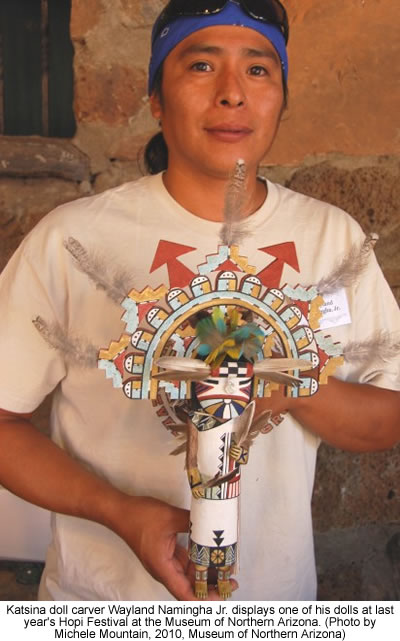 |
Canku Ota
|
 |
|
(Many Paths)
|
||
|
An Online Newsletter
Celebrating Native America
|
||
|
July
1, 2011 - Volume 9 Number 7
|
||
|
|
||
|
Hopi Artisans
Come to Flagstaff to Share Their Culture
|
||
|
by BETSEY BRUNER Arts
& Culture Editor
|
||
|
Such was the case when the Museum of Northern Arizona offered to store the more than 850 cultural pieces in the Beenhouwer Fine Art Collection, which was donated to the Hopi Tribe in 1999 by Herb and Bernice Beenhouwer of Santa Fe. This impressive collection includes Native American fine art, predominantly from the Hopi, New Mexico Pueblos, Navajo, Tohono O'odham and Apache Tribes. The Beenhouwers began collecting on their travels throughout the Southwest in 1966. Over three decades, their collection grew to its present size. "I actually saw this collection in his house once," said Robert Breunig, director of MNA. "There are a lot of really nice katsina dolls, baskets and jewelry, but the collection was largely uncatalogued." In 2009, the Hopi Tribe and MNA received funding from the Institute of Museum and Library Services to complete a comprehensive inventory and documentation of the entire collection. After about 1 1/2 years, the cataloguing, which has been conducted by Lyle Balenquah, MNA's acting curator of anthropology, is nearing completion. Next weekend Balenquah will give a talk about this extensive project during the 78th annual Hopi Festival of Arts and Culture at the museum. "The Hopi Tribe is excited about this collection," Breunig said. "The Hopis do not currently have a museum. Hopefully, this will provide an impetus to get some kind of museum out at Hopi." SPECIAL
RELATIONSHIPS This long-standing gathering represents the partnership between the Hopi people and MNA, and has always had the mission of preserving Hopi artistic traditions and creating a marketplace for Hopi goods. Through the years, the event has become a regional tradition for artists and collectors, and a must for visitors seeking an authentic cultural experience. In recognition of its cultural contribution, the Hopi Festival was given a Viola Award by the Flagstaff Cultural Partners this year "I think it's an event that all of us here at the museum look forward to every year," Breunig said. "It's our best-attended festival. I think what makes it so special is the well-established relationship the museum has with individual artists and their whole families, going back several generations." He said the great-grandparents in Hopi were interacting with the original founders of MNA, zoologist Harold S. Colton and artist Mary-Russell Ferrell Colton, who were from Philadelphia and dedicated to preserving the history and cultures of northern Arizona. TRIPS
TO THE MESAS Collecting trips have always been an important part of the Hopi festivals, as they are today, allowing artists who produce only a few items per year a chance to sell their work. With 75 artist booths and a consignment area, hundreds of distinctive art pieces, including quilts, rattles, pottery, katsina dolls, paintings and baskets will be on display and for sale. Before the official festival opening, work will be judged "An important part of the festival is the 30-plus awards that are given to artists who excel in their arts category," said Anne Doyle, manager of the Heritage Program. "Sponsored by businesses and individuals, the awards are juried by art professionals from the region. At the festival, award ribbons are on display at the artists' tables, making it easy to spot the finest collectable art pieces." The talk by Balenquah is part of the Heritage Insight Presentations. There will also be discussions on Hopi farming, Hopi migration and a "Hopi 101" talk by artist and educator Ramson Lomatewama, as well as a presentation by Anita Poleahla on "Teaching Hopi Language from a Hopi Perspective" and a "Hopi Pottery" demonstration by potters Dorothy and Emerson Ami. Breunig said this kind of exchange is essential for cultural understanding. "In Arizona at this time, we cannot do enough to cultivate respect for other cultural traditions," he said. "I believe very strongly that one of the principal roles of the museum is to be an example that even though we are different, we can share and celebrate these traditions, not just locally, but statewide."
Museum
of Northern Arizona |
|
|
||
|
|
||
| Canku Ota is a free Newsletter celebrating Native America, its traditions and accomplishments . We do not provide subscriber or visitor names to anyone. Some articles presented in Canku Ota may contain copyright material. We have received appropriate permissions for republishing any articles. Material appearing here is distributed without profit or monetary gain to those who have expressed an interest. This is in accordance with Title 17 U.S.C. Section 107. | ||
|
Canku Ota is a copyright ©
2000, 2001, 2002, 2003, 2004, 2005, 2006, 2007, 2008, 2009, 2010,
2011 of Vicki Barry and Paul Barry.
|
||
 |
 |
|
|
The "Canku
Ota - A Newsletter Celebrating Native America" web site and
its design is the
|
||
|
Copyright ©
1999, 2000, 2001, 2002, 2003, 2004, 2005,
2006, 2007, 2008, 2009, 2010, 2011
of Paul C. Barry.
|
||
|
All Rights Reserved.
|
||
 It's
nice to have a neighbor who can help you store precious items when
you don't have the room at your home.
It's
nice to have a neighbor who can help you store precious items when
you don't have the room at your home.